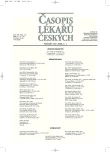Importance of Quantitative Evaluation of BCR-ABL Transcripts Using Real-time PCR for Effective Treatment of Chronic Myeloid Leukemia
Authors:
M. Beránek; J. Voglová 1; A. Sýkorová 1; D. Belada 1; M. Bláha 1
Authors‘ workplace:
Ústav klinické biochemie a diagnostiky LF UK a FN, Hradec Králové
; II. interní klinika, oddělení klinické hematologie LF a FN, Hradec Králové
1
Published in:
Čas. Lék. čes. 2006; 145: 25-29
Category:
Original Article
Overview
Background.
Molecular biology methods based on reverse transcription and polymerase chain reaction (RT-PCR) are able to detect the presence of BCR-ABL transcripts in chronic myeloid leukemia (CML). In this study we present our experience with monitoring of residual disease using real-time PCR with hybridization probes detection in patients treated with imatinib mesylate and in collected peripheral blood progenitor cells (PBPC).
Methods and Results.
We measured the level of BCR-ABL transcripts in peripheral blood cells of 27 subjects before and in the course of the imatinib treatment. The median of relative quantity of BCR-ABL in the blood before imatinib therapy was 2.55%. The number of the transcripts in 23 imatinib-sensitive subjects decreased to 0.02% in 6 months. After 12 months of the treatment the BCR-ABL median was 0.005%. Subsequent levels fluctuated between values below the detection limit (DL, 0.001%) and 0.005%. Three patients were primarily resistant to imatinib with the BCR-ABL range of 0.13%-11,7% during the treatment. One subject showed marks of molecular relapse after 18 months of the treatment. Only two of 16 filgrastim-stimulated patients had BCR-ABL levels in the blood and in collected PBPC below DL. In other subjects BCR-ABL transcripts were determined within the measurable range of RT-PCR.
Conclusions.
Taking into account prognostic importance, the measurement of BCR-ABL transcripts is an effective approach to monitoring of residual CML kinetics. Evaluation of BCR-ABL levels in collected PBPC can complete information on quality of the cells in potential autotransplants, and choose subsequent therapeutic protocols and patient prognosis.
Key words:
BCR-ABL, RT-PCR, imatinib, minimal residual disease, leukemia.
Labels
Addictology Allergology and clinical immunology Angiology Audiology Clinical biochemistry Dermatology & STDs Paediatric gastroenterology Paediatric surgery Paediatric cardiology Paediatric neurology Paediatric ENT Paediatric psychiatry Paediatric rheumatology Diabetology Pharmacy Vascular surgery Pain management Dental HygienistArticle was published in
Journal of Czech Physicians

Most read in this issue
- Impact Factor – Good Servant, but a Bad Master
- Acute Toxicity of High Dose Interstitial Brachytherapy Boost in Prostate Cancer
- Abuse of Buprenorphine Becomes a Problem of the Czech Republic
- Principle and Importance of Using the Array CGH in Hematooncology
